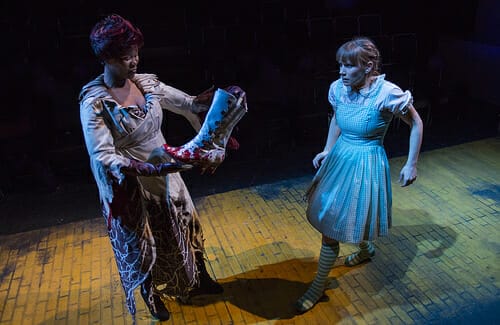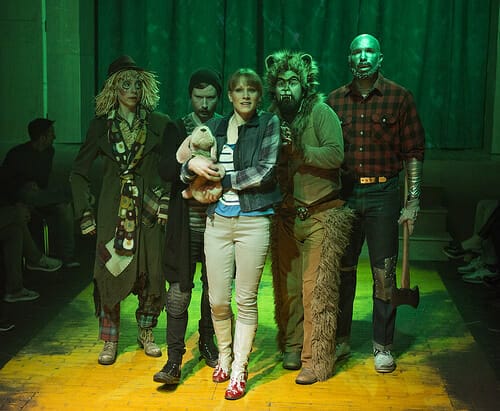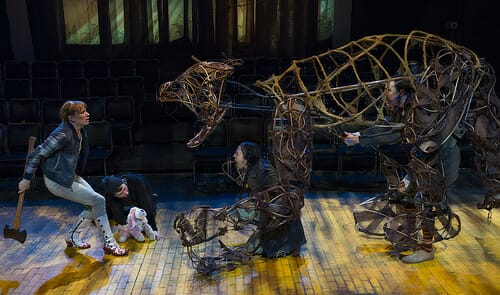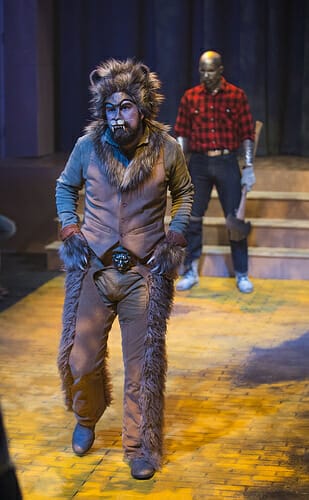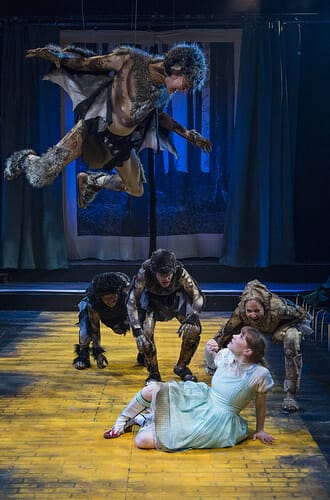The Great and Terrible Wizard of Oz, adapted from the book by L. Frank Baum and now playing at The House Theatre of Chicago is not the Judy Garland classic many people were raised on. Though Phillip Klapperich’s adaptation adds some twists and turns to the classic tale in modernizing it, the set-up ultimately remains the same. A girl named Dorothy, living in Kansas with her Aunt Em and Uncle Henry, is transported by tornado to a magical world of wizards, wonder, and wicked witches. She embarks on a quest to find the Wizard of Oz, in the process meeting a talking Scarecrow, Tin Woodsman, and Cowardly Lion, and learning a lesson or two along the way. All of this is familiar territory to most viewers; however, there are several additions to the production which attempt to modernize the narrative, some more successfully than others.
The Great and Terrible Wizard of Oz Adds Own Twists to Classic Tale
In modernizing this tale for contemporary audiences, the production takes some liberties with the story, at times adding a rougher edge of darkness to the mostly-light story. Dorothy, for example, has a smart phone and is interviewing for a prestigious school at the top of the show. They ultimately decline her application as a result of her lack of clear passion, making her journey to the Wizard as much a quest for her identity as it is a way back home. Klapperich also embraces the more “terrible” aspects of Oz in addition to what makes it “great.” Dorothy is frequently referred to as a “Witch Slayer” throughout the production in reference to the events that have granted her power in this world. Additionally, the “ruby slippers” of the original storyline have been replaced by blood soaked rain boots.
Another major addition in this updated take on the story is the presence of a monster in the woods, the Kalidah, which attacks the travelers along the way. This monstrous puppet, impressively designed by Jesse Mooney-Bullock, looks like a cross between a bear and a horned bull, towering over our heroes until it loses a limb to the Tin Woodsman's axe. While the inclusion of this scene is both exciting and imaginative, it doesn't feel completely substantive. The choice feels more in service to the spectacle of The House's mission to stage “amazing feats of storytelling” than to the story of a heroine coming into her own.
Immersive Design At The House Theatre
While the content of The Great and Terrible Wizard of Oz is at times darker than the original source material, the world of the play has been mostly designed in similarity to its classic 1939 iteration. Mieka van der Ploeg’s costume design is bright and colorful, with special attention paid to the Scarecrow, Tin Man, and Lion.
Here, van der Ploeg’s work with textures really helps to establish the materials that make up each character, be they tufts of straw poking from sleeves, the chrome-painted head of actor Jeremy Sonkin, or the Wild West inspired fur chaps worn by the Cowardly Lion. Costuming diverges into darker territory with the design of The Witch of the West, whose fiery streaks of red hair and malevolent makeup combine with a spiderwebbed white dress to create a character who appears truly wicked.
The yellow brick road also separates two banks of audience, with the action staged mostly in the middle on a playing space similar to a runway. Behind each section of audience are screens that display the magical projection design of Joseph A. Burke, displaying everything from a field or red poppies to two magical streams colliding in a supernatural battle.
Unfortunately, the unique configuration of the audience combined with a shadowy tree backdrop that rests in front of the screens obscures these projections at times, and there are other times when actors’ blocking feels similarly ill-suited for this kind of performance configuration.
This "Oz" Places Theatrics At the Forefront
If there is one reason to see The Great and Terrible Wizard of Oz, it is for its committed approach to pushing the limits of typical storefront theatrics. From the gargantuan Kalidah to puppet crows and wolves, it is clear that director Tommy Rapley has chosen to emphasize spectacle above all else in his production. This decision is made no clearer than in the scene featuring an attack on the party of travelers by the Witch of the West’s fearsome winged monkeys. Despite The House’s small playing space, several actors are flown through the air, performing chaotic acrobatic maneuvers inches above audience members. The short-lived, though exhilarating scene is the high point of the production, heightening the tension while in service to the story.
Families Be Wary
The graphic and manipulative death of a beloved character in Act II gives me pause about recommending this piece for families, even at The House's suggestion of kids 10+. At the matinee I saw, many audience members (there were two visiting groups of high school and college students) were visibly torn up for the remainder of the performance, speaking to the affecting nature of a scene which blindsided all present. While I understand the desire to darken the source material and open up a conversation about death, The Wizard of Oz doesn't strike me as the best vessel for this message, nor do I think the production earns this moment or illustrates how it comes to truly define Dorothy. This major departure from the source material, as well as the particularly ghoulish image of the Witch of the West peeling the skin from her body when water is thrown on her feels a bit more PG-13 than most theatre for younger audiences.
Somewhat Recommended
Top Pick for: Fans of inventive spectacle
Not Recommended for: Families with young children, Wizard of Oz Purists
Note: An excerpt of this review appears in Theatre in Chicago.
Where:
The Great and Terrible Wizard of Oz plays at the Chopin Upstairs Theatre, 1543 W. Division St.
When:
The Great and Terrible Wizard of Oz runs through May 7th, 2017. The performance schedule is Thursdays - Saturdays at 7:30 p.m., Saturday and Sunday matinees at 3 p.m. and Sunday evenings at 7 p.m.
Tickets:
Regular run tickets range from $30 – $45. The show is recommended for adults and kids aged 10 and up. Same-day tickets for students and industry professionals are $15 and available for all dates, seats permitting. For more information and to purchase tickets, please visit www.thehousetheatre.com or call 773.769.3832.

